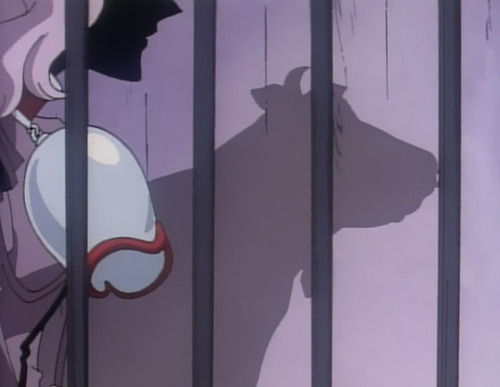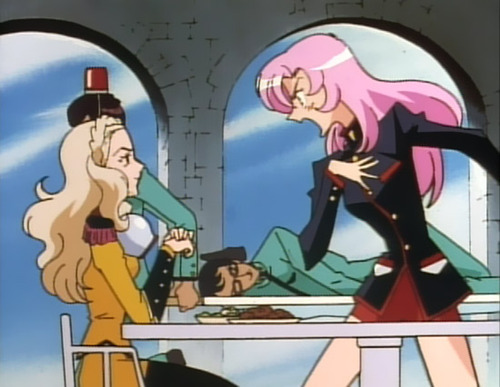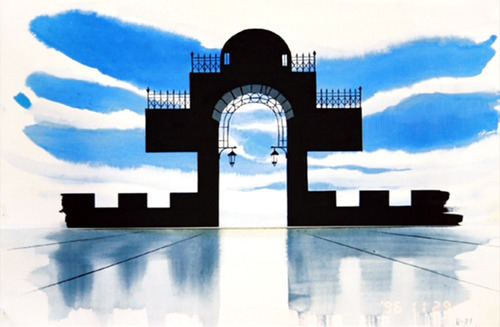In which Ikuhara had a fever, and there was only one prescription for it.

Click here for an explanation of the watch party, and an invitation to chime in with your own thoughts (Tumblr tag: #Utena Watch Party).
For Returning Viewers, Vrai’s episode analysis is here for your reading pleasure:
And my own newbie-friendly commentary is below the jump.
Notes from Next Door
This commentary assumes you’ve at least seen the episode(s) under discussion. It occasionally hints at future events or calls attention to recurring themes, but will be free of specific spoilers unless otherwise noted. As a reminder, please be courteous to newcomers in your comments and mark all spoilers as such.
Opening Chatter
Usually I write these posts the Saturday after Vrai’s analysis goes out, but I’m writing this one almost a week in advance because, by the time it goes live, I’ll be out of town and with limited computer access.
When I did the math and realized my out-of-town week would be “The Cowbell of Happiness,” I breathed a sigh of relief and figured I’d just use this as an excuse to post some creator commentary I’d transcribed from the Utena booklets about the show’s artwork and influences. “I mean, it’s The Cowbell of freaking Happiness,” I thought. “How much could I possibly have to say about it?”
Ha.
HAH.
I’ve got two hours to write, edit, and prep this sucker. Let’s freaking begin.
A Comedy of Terrors

In some ways “Cowbell of Happiness” is a kind of successor to last cour’s “Take Care, Miss Nanami,” as it’s another absurd, humorous Nanami-centric episode. And yet I confess to never finding this episode particularly hilarious—strange and surreal, certainly, but it never makes me giggle the way those early-series silly episodes do.
The reasons for this, I think, are twofold: One has to do with where the audience stands while watching this episode, and the amount of knowledge we now possess. Take, for example, Nanami’s recurring concerns about her brother. In “Take Care,” she’s convinced he’s trying to kill her. She’s honestly afraid of this, but we can laugh as audience members because we’re certain this would never happen—Touga has done nothing at that point to suggest he ever would, and if anything seems to genuinely care about his sister.
Now, though, we’ve seen Touga’s willingness to manipulate those close to him, including his little sister. So when she has a nightmare about Touga sending her off to the slaughterhouse (and later feasting upon her), it’s not silly so much as chilling. Suddenly Nanami’s (primarily subconscious) fears don’t seem so ridiculous after all, and instead of brushing her off as a paranoid child, we have to wonder if her instincts aren’t a whole lot sharper than we first thought.
The second reason this episode has always struck me as more absurd-horror than absurd-humor (I don’t want to use the word “Kafkaesque” but oh look, there it is, just sitting there) is that it speaks to what I see as a universal fear, particularly among adolescents: The fear of transformation, of metamorphoses, of “becoming” something new—and not just something new, but something you never wanted to become in the first place. I talked a little about transformations in last episode’s post, and we’re continuing to see those themes explored here, albeit in a very different way.
Nanami brings her transformation on herself through her willful ignorance, and Team Utena rescues her before the episode is over, so things basically work out in the end. But, as with Nanami’s nightmare, there’s a darkness lurking beneath the goofy cow jokes, and a question about exactly what these kids will become—and how easy it would be for them to turn into something or someone they never intended to be.
Cows and Princes; Or, “We are who we pretend to be”

This is one of the few episodes of Utena that provides a fairly straightforward moral, at least on the surface. The shadow girls tell us this is a “reap what you sow” tale (similar to “Curried High Trip”), Jury provides us with the obvious moral about the dangers of materialism and obsessing over outer appearances, and we could be happy to leave it at that. But there’s more going on here, and it has as much to do with Nanami as it does with our protagonist.
Utena and Nanami have a strange relationship. They openly dislike each other, which means they have no qualms in telling the other exactly what they think. So Utena is the only person willing to approach Nanami and tell her that she’s wearing a cowbell, meant for cows, and it’s weird; and Nanami is the only one who will snipe right back that Utena is wearing a boy’s uniform, meant for boys, which is plenty weird, too.
My knee-jerk reaction to this comparison was that it was a faulty one. After all, Nanami is wearing the cowbell to impress others, while Utena is wearing the uniform out of personal preference (and has made it very clear that she couldn’t care less what others think about it). But then I come back to a couple stray thoughts which lead me to believe that, once again, Nanami and Utena are more alike than either would care to admit.
First, the moral I’ve included as my heading, which I see as the real central theme of the episode: “We are who we pretend to be.” Nanami wears a cow bell and her interior gradually comes to match her exterior, until she not only behaves like a cow, but literally becomes one. Similarly, Utena wears a princely uniform as part of her desire to become a prince. Again, Nanami is wholly ignorant of what she’s doing while Utena is at least superficially aware, but in both cases we see interior changes occurring only after external changes—performance becoming habit becoming psychology, which eventually becomes truth.
Second, a line that jumped out and smacked me in the face during this rewatch: Utena chiding Nanami for “wearing something without understanding what it is.” This isn’t merely a case of someone pretending until it becomes the truth (which isn’t necessarily a bad thing and can lead to positive behavior changes); instead, this is someone pretending to be something they don’t even understand until it becomes the truth. And, again, I think this is one of the great dangers of adolescence: that parroting half-understood behavior (especially negative behavior) will internalize that behavior, until the person comes to take on those traits without ever understanding exactly how or why they think and act the way they do.
Which brings us back to Utena, who wears her princely guise without fully understanding what it means to be a prince, or how the very existence of princes requires the existence of princesses (which in turn requires victims and power hierarchies, to say nothing of the gender inequality inherent in the two terms). Our characters are still very much defining themselves as they move from childhood to adulthood, Utena included, and if this episode is a cautionary tale about the dangers of performance, then it’s a tale meant as much for its protagonist as it is for its audience.
The Art of Utena
Okay—even after rattling off all that, we’re still a little shorter than usual. And I do have all these neat transcribed selections from the booklets (translated by Sarah Alys Lindholm) that come with Nozomi’s Special Edition box sets, so I might as well post some of it here. These are just selections that struck me as particularly interesting. Of course, if you want to read the entire interview or article, you could always buy the box sets~ ♪
A Fanciful Reality

Excerpts from an interview with conceptual designer Nagahama Hiroshi (Fruits Basket, Mushi-shi):
On becoming the background designer:
It had been arranged that I’d draw some image boards for him before we met, so I did an aerial view of the dueling forest and designs for the greenhouse and Ohtori Academy gates, and I brought them to the studio. Then, when I gave explanations, like, “I got the impression Anthy was held captive in the greenhouse, so I gave it a birdcage shape,” [Mr. Ikuhara] said right there on the spot, “You be the background art designer.” …He went to the phone at his desk and called someone, then walked back over to me. And then he said, “I just got the art director I’d reserved to quit, so you’ll have to design the backgrounds. There’s no other choice now.”
On the dueling arena, the castle, and the dueling gates:
[…] About the [dueling] arena with the slanting pillar, the first thing Mr. Ikuhara told me was, “It’s like a symbolic rendering of the path that leads to Cinderella’s castle.” Paths in fairy tales tend to twist and turn, you know? That’s the basic image. And as for the castle hanging in the sky—Mr. Ikuhara said, “How about we have the dueling arena be its own open, discrete space, and we have a castle dangling down from above like a chandelier? …Something with lots of sparkly decorative lighting, like the castle at Disneyland, would be best.”
…Mr. Enokido’s scenario [for the dueling arena gate] had an image of a noisily-moving mechanism… On top of that, I made the rose look like bird wings when it was open. It’s a bird because it’s Ohtori [meaning “phoenix”] Academy, but since the school is a slightly uncanny, imperfect one, when the gate is closed the bird has no head.
On the academy campus:
I drew it shaped like a zenpo-koen-fun [a type of ancient burial mound shaped like a keyhole], and I designed it so if you look closely, the grounds form a rose.
Excerpts from an interview with art director Kobayashi Shinichiro (Berserk, Nodame Cantabile). Bold text indicates the interviewer.
We overturned reality, we broke through reality’s shell and created the world in a new image. In other words, the task was to create a world where those things wouldn’t feel unnatural. Take the academy: we smashed it and overturned it. It ignores the natural laws of gravity involved in architecture… There’s no way [the dueling arena’s foundation] could support that weight. It contradicts gravity. I think it’s expressing natural laws that exist within freedom, independently of reality’s fetters.
[…] We’re living bound by gravity, aren’t we? We couldn’t go on without it. But it’s a fetter: a way in which we’re not free. In the realm of images, you can freely tear down gravity. I have the feeling it was all about the pursuit of that sort of freedom.
[…] Mysterious things happen at the academy, but the characters are doing things that are everyday, or rather, are realistic… Perhaps when humans are living real lives, the work takes a different course from fantasy even when you make it abstract?
You have reality as the basis, and from there you abbreviate and deform. We escalated that to an extreme here. We started with reality and accentuated. Because if we’d started with dreams, it would have ended up a fantasy work.
That must be the natural law; you do sense gravity in there somewhere. I know Director Ikuhara carries the message that it should “make its echoes felt in the reality of the viewer.” He doesn’t want it to be a mere fantasy or dream. Perhaps that has something to do with it.
—————
Screenshots snagged from Empty Movement.

One thought on “Utena Watch Party: Episode 16”